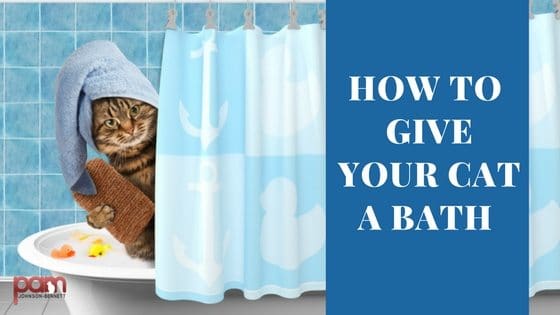
Why Would Your Cat Need a Bath?
For most cats, a bath will never be necessary. Cats do such an amazing job of grooming their coats and keeping themselves very clean. There may a situation however, where you have to bathe your cat. If you allow your cat outdoors you may find they had an unfortunate close encounter with a skunk. A cat with a severe flea infestation may also need a bath to provide some immediate relief before you use a topical flea prevention product. If your cat has a flea allergy, your veterinarian may recommend a special shampoo to help relieve the itch and skin irritation.
A bath may also be necessary if your cat has gotten something on the fur, either sticky, irritating or toxic. Keep in mind, anything that gets on the cat’s fur will also be ingested when grooming so if they have gotten into something it’s important to get it removed immediately. If it’s an irritant or toxic, call your veterinarian right away.
Cats who are obese or less mobile (maybe due to arthritis) may not be as efficient at self-grooming or may be totally unable to reach important body part so they might need the occasional bath.
Another common reason for bathing would be if your cat develops ringworm. If that’s the case, your veterinarian will prescribe a specific shampoo to use and instructions on how often to bathe.
Some cat breeds also benefit from baths as well. Sphynx cats tend to develop oily skin and need more frequent bathing. Some longhaired breeds also need bathing as well.
Although most cats don’t ever need to experience a bath, if you find yourself in a situation where a wipe-down with a damp washcloth isn’t sufficient, then it’s important to be prepared and have a game plan.
Prepare Your Cat in Advance Before Attempting a Bath
First, if you’re concerned or afraid that your cat will completely freak out and you won’t be able to handle it, or if you know from previous experience that the bath will result in injury to yourself, then talk to your veterinarian. Your veterinarian and staff are trained and well-equipped to bathe cats who don’t want to be bathed. You can also choose to take your cat to a professional groomer but make sure you get a recommendation for a groomer who uses gentle and humane handling techniques. There are many groomers who are used to handling cats and their environment may prove to be less stressful than the veterinary clinic. Visit the groomer beforehand and make sure you’re comfortable with the surroundings, cleanliness, and handling techniques.
If you decide to bathe your cat at home, you’ll need to do some preparation to make it safer and more efficient. Start by trimming your cat’s nails to reduce damage should you end up getting scratched. If you have a longhaired cat it’s also important to completely brush the coat to remove any mats. If you bathe a cat with mats then you’ll just make it more difficult to remove them afterward as the water will cause them to tighten even more.
Choose Your Location
Typically, the tub is the most logical choice but if you have trouble leaning over, then you may want to bathe the cat in the kitchen sink. The good thing about the tub is that you can close off the bathroom to reduce how far kitty can get away should she escape from your grasp. It’s also easier to warm up a smaller bathroom than a kitchen and you definitely want to make sure the room is warm enough to prevent your cat from getting chilled.
Get Your Supplies Ready Before Bathing Your Cat
- You’ll want to have everything set to go before you even attempt to place your cat in the tub. Here are the things you’ll need:
- An assistant (if there’s someone who can help you, it’ll make the process much easier)
- The appropriate shampoo (use cat safe shampoo only. If in doubt, talk to your veterinarian)
- Soft washcloth for face cleaning
- Handheld spray attachment (set to very gentle)
- Several soft towels
- A quiet hair dryer (your cat may freak out at the dryer but have it there just in case)
- Rubber mat to place on the bottom of tub for your cat to grip onto (kitty will feel more secure)
- Cat carrier (in case the cat can’t handle the dryer, you can place her in there for a short time to dry)
- Cotton balls (You’ll put a half of a cotton ball in each ear to prevent water from getting in there)
- Plain ophthalmic ointment (put in each eye to prevent shampoo irritation. Get it from your veterinarian)
- Cat harness (if you think you may have trouble holding your cat, a harness may be easier)
- Proper clothing for you (wear long sleeves to lessen damage from any cat scratches)
Get the Location Ready
- Make sure the room is warm
- Place the rubber mat in the tub and run warm water to take the chill off the surface before placing your cat there
- Open shampoo bottle and have it handy (same with conditioner, if using)
- Place all supplies within easy reach
- Calm yourself before getting the cat because they’ll sense your nervousness
Bathing Your Cat
Make sure you’ve put the cotton balls in your cat’s ears and the ointment in the eyes. Test the water to make sure it’s a comfortable temperature and then carefully place your cat in the tub. Start by getting the feet and legs wet and then work up to the rest of the body. Avoid getting the head wet until the very end because that will probably be the area that freaks your cat out the most. If you’re dealing with a severe flea infestation though you’ll want to shampoo the head first to prevent the fleas from running into the eyes, nose and mouth.
When you rinse your cat, double check for any areas where there may be some residual shampoo (such as in the armpits or on the underside. Leftover shampoo can cause irritation so you want to make sure the cat’s fur is completely rinsed.
When the bath is done, be ready to wrap the cat in the first towel immediately. Keep changing to dry towels to absorb as much water as possible. The last thing you want is for a soaking wet cat to go running through the house leaving a trail of water everywhere.
If you use the hair dryer, set it on the lowest setting and don’t blow it directly in the cat’s face and don’t blow the air too close. A cat’s skin is very sensitive and can easily get burned. If your cat completely freaks out at the sound or feel of the dryer then place kitty in a cat carrier lined with a towel so she can calm down and spend a little time drying in there. If you just let the cat run through the house while wet she’ll certainly end up chilled.
If you know your cat will accept treats you can try distracting that way while either using the dryer or holding her in a dry towel. For some cats though, the experience may be too stressful. The most important points to remember about bathing your cat will be to get it done quickly, safely, and calmly.
Need More Information?
If you aren’t sure whether your cat needs a bath or are afraid to do it yourself, talk to your veterinarian or a professional cat groomer. The experience needs to be safe for both you and your cat. And remember, don’t use any shampoo or conditioner that isn’t intended for cats.
For more information on cat behavior and training, refer to the best-selling books by Pam Johnson-Bennett. Pam’s books are available at bookstores and online. We’ve included links to Amazon here on our website.
If you have a question about your cat’s behavior or health, contact your veterinarian. This article is not intended as a medical diagnosis nor is it a replacement for your cat’s regular veterinary care. This article is for general information purposes only.




